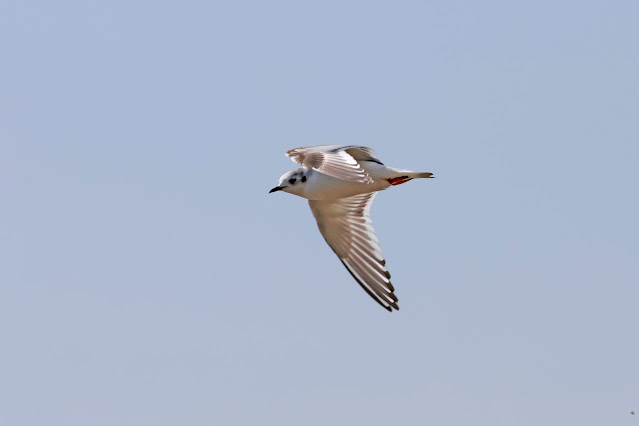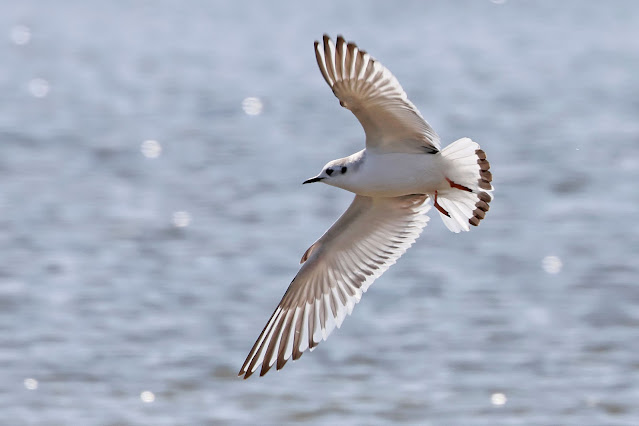There had been a change in the weather with the arrival of the Easter weekend. When I left home the skies were clear and there was and air frost. As I came down the hill towards West Meon though there was a quite thick mist hanging in the valley, the mist stayed with me all the way to Hill Head, where I was greeted with another of those beautiful sun rises.
Looking down Duck Bay the mist hung over the reeds and water.
There was mist and easterlies and then turning to south easterlies, onshore winds that will be ideal for sea watching, however it was maybe a little early, still I stuck it out, but very little if anything was moving. Out on the water were six Eider but distant along with one Great-crested Grebe. We gave it an hour and a half and then decided to check the bushes around the chalets and up on Brownwich Cliffs. As we walked away a Peregrine came from the west passing overhead.
I was to learn a big lesson today about my new camera, and you may pick up the problem with some of the images, but I will explain later on what exactly the problem was and what going forward I have to do.
There were plenty of Linnet singing from the scrub along the footpath from the reserve entrance.
Having negotiated the muddy path at the first clearing there was still nothing happening out on the sea, but he view was wonderful.
Down below the dog walkers were disturbing the Brent Geese that still remained, soon they will all be heading north.
In the field there were three Buzzards, two on posts and the other running around like a Caracara, probably looking for earthworms. There were plenty of Skylark about and one or two Lapwing.
Back on the water the only success from the sea watch was a couple of Whimbrel, my first for the year the passed heading east.
Walking back to the car there was a bit more song in the bushes, Chiffchaff and Blackcap were in song along with bursts from a couple of Cetti's Warblers. Another Linnet along the footpath.
Last week the water level on the south scrape on the reserve was the highest I have seen it, today from the Meon Shore Hide it was a little lower and some of the islands were now visible.
Right in front of the hide on the bank was a male Shoveler. It was preening but showed off the impressive bill very well.
The noise levels were still; the same with the continuous calls and squawks of the Black-headed Gulls. There was also signs of nest building, these two trying to find a suitable spot for two bits of reed.
I left the hide and decided to walk to the Spurgin Hide, hoping that there might be some activity in the bushes alongside the path. This Chiffchaff was in full song, showing well at the top of the willow.
Wrens were also showing in amongst the scrub and dead bracken.
At the Spurgin Hide the water levels were also very high and other than a couple of Little Grebe there was not much on the water. What was of interest though was a female Marsh Harrier that appeared to be interested in a spot to the left of the hide.
The light wasn't good, the harrier being back lit, but there was also the problem I had with the camera settings that I could not see.
She would drop into the same spot in the reeds and then reappear but there was no male harrier in attendance.
the little Grebes came close to the hide and again there was the problem with the light, but I quite like the result with the reflection in the water.
It was a case of long flights interspersed with short flights around the reeds.
The light was getting worse as we approached the middle of the day so I decided to leave and try somewhere else. There had been some good reports from Farlington Marshes, with the Short-eared Owls still present and also a couple of Little Gulls had been present on the stream for almost a week.
From the middle car park I walked through the bushes with Blackcap singing from the hawthorn. I could hear the pings of Bearded Tit from the reeds as I walked towards the visitor hut. On the stream at the back of the hut a pair of Lesser Black-backed Gulls were present, looking very smart in the sunshine.
I quickly found the Little Gulls on the stream, they are a second winter bird and a first winter bird and whilst I found them on the water they were quickly up into the air hawking over the water, twisting and turning as they dipped to pick insects off the water.
The first winter bird
The second winter bird, whilst lacking the black hood of adult hood, showing a darkening of the under wing.
I was joined by a Swallow on the wires of an old fence in the water. My first photographs of the year.
I took some shots of one of the gulls on the water and realised that something wasn't right, the image appeared blurred and looking closer on the back of the camera it was grainy. I checked the screen and realised I had been shooting at an ISO of 32000 when normally I use the auto setting!
What wasn't clear was why, then I realised the screen on the back of the camera has a quick menu option that allows you to make changes with a touch screen, there is also the facilty to turn this around do it could happen accidentally. Of course I didn't and I can only assume this is what happened. I reset the ISO and turned the screen around. You can see the difference in these images, this one the second winter.
The smallest gull in the world, it is compact with short
legs, short rounded wings, and small bill. Whilst this bird is aged as a
second winter bird it shows a lot of the adult non breeding plumage with a
black ear patch and dark underwing, this bird will probably go into adult
plumage with a black head, pale grey back, white wingtips, and blackish
underwings.
And here the first winter bird.
And some nice views of the first winter bird as it hawked around the stream.
Here showing the lighter underwing of the first winter.
I had been photographing a group of four Avocet earlier as the fought and jumped around but this was with the high ISO setting, the results were not good. This was one after changing the setting.
The sun was quite strong so I decided to head back to the car to get some sun cream and after some lunch I walked to the Lake where with the rising tide waders were gathering. I could see Redshank and a single Greenshank and quite good numbers of Black-tailed Godwits, many of which were in summer plumage.
As I left the Lake I was later informed two shorties appeared, but I missed them. A little further on I was watching a very smart drake Shelduck.
A pair of Gadwall were on one of the pools close to the path.
Overhead I was treated to a fly past by two Hawker Hurricanes, whilst the Spitfire gets all the world war two plaudits, it was in fact the Hurricane that was the most important plane.
On reaching Point Field I was told all about how well the Shorties had performed a little earlier. I was left with a pair of Tufted Duck, surprisingly in the ditch close to the path.
I walked back to the visitor hut and the stream, I wanted another chance with the Little Gulls, as I approached there were Mediterranean Gulls calling high above me.
With my first Reed Warblers of the year singing from the adjacent reeds it was back to chasing the Little Gulls around the water. Here the first winter bird
First-winter birds are similar to nonbreeding adults but
with blackish “M” pattern in upper-wing, dark tip to tail, much paler legs, and
no dark underwing.
The Little Gull’s graceful flight style recalls a tern,
except for its rounded wingtips. It feeds like a tern too, flying low over the
water and sometimes hovering to catch insects, small fish, and aquatic
invertebrates.
They present a photographic challenge as they twist and turn quickly and I could have stayed for quite a long time, but eventually decided to move on, and retraced my tracks clockwise around the marshes.
I paused at Point Field in hope there might be an appearance of one of the owls. I sat on the bench and enjoyed the sunshine, but it didn't seem right waiting for Shorties in warm weather it had to be a cold sharp afternoon.
The tide was still high and I could hear the call of a Sandwich Tern. I found it fishing just off shore.
I eventually reached the lake which with the sunshine looked quite spectacular.
A Little Egret was hunting in the shallow water to the south side of the lake behind the reeds.
There were good number of Avocets all over the lake, mostly feeding in pairs this lone Avocet stood out as it roosted behind the reeds.
Whilst they were all paired up there was conflict between pairs, I was alerted to this by the chittering calls as the birds argued amongst each other.
I was about to leave when I noticed a drake Teal on the edge of the reeds, the sun was catching the markings on the head and this was contrasting with the reflection of the reeds in the water.
I left the Lake and headed back to the car. A day that weather wise promised much actually didn't turn up what I hoped, but I did manage a few year ticks, an opportunity to watch the enigmatic Little Gull and to learn more about the Canon R7, fortunately the problem with ISO settings did not spoil the day.
































































No comments:
Post a Comment